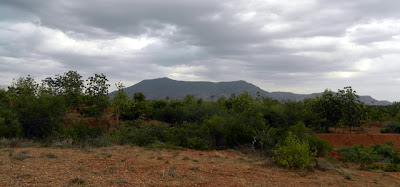I've been wanting to get into the forest since we arrived in Tamil Nadu, so the news that we would actually go out to see Viralipatty Forest and the nearby village of the same name after an office visit with the head forestry official of the Madurai district was good news to me. I didn't care how late it would make us getting back to the hotel. Mr. Rakesh was an affable and knowledgeable technocrat in khakis, an out-doorsy knit shirt, and expensive hiking boots. He had studied for two years with the U.S. Forest Service in Colorado and while he didn't have all of his statistics straight, or offer anything particularly new and innovative, he seemed to be doing more or less all the right things in managing his forest district. (Full disclosure: that assessment was made by Kerry Fegasun. I wouldn't know personally.)
Robert G. and I got to ride the Forest Service suv on the way out to the village. A man in uniform with a huge mustache who appeared to only speak Tamil squeezed into the back seat with us while Mr. Rakesh sat up front with the driver. We passed through the village and arrived at a gate. Another Tata suv was parked there and four men in green forest service uniforms lounged in plastic chairs nearby. When they saw us pull up, they leapt to attention and then scurried to the suv and piled in. Then one of them, with green and yellow piping on his shoulders and more authoritative hat scurried back, grabbed a briefcase, and climbed back into to the truck. We pulled through the gate and they followed behind, while the bus filled with our fellow Fulbrighters brought up the rear. As we went along the dirt road got rougher and we kept looking back to see if the bus was still following. When we started rolling over low scrub, the bus driver finally decided he had gone far enough and stopped. It was decided that we would all walk the rest of the way up to the edge of the national forest. The crew in the second suv drove on ahead and then ran back down like two-legged green mountain goats to meet us.
The terrain was rocky and steep, with thorny scrub plants. It reminded me of parts of Texas actually. We hiked up a trail to a marker near a catch dam. Where Mr. Rakesh pointed out some of the new tree plantings they had done. We saw teak trees and neem trees and several others that I wouldn't recognize again if they fell on me. We walked up to the catch dam, too high to see over, and thought about how much water must run down that ravine during the monsoon rains for it to be so high. The purpose of a catch dam is to slow down the run-off from the hills, thus getting the silt to settle and slowing erosion while giving the water time to soak into the ground and recharge the water table instead of running off down the highway at the bottom of the valley.
We wandered around, snapping pictures and trying not trip over the thorns while looking up at the gorgeous landscape. When we looked back at the forest rangers, they were setting out biscuits (cookies in America) and tea on the hood of their suv. Really. Nobody in India is going to get caught failing to serve tea apparently, even if its in a national forest. After serving tea, which was really the first time the men appeared to do anything useful, although I heard someone refer to them as guards, they collected our trash and we began the trek back down. The visit the village and the self-help group sponsored by the forest service deserves it's own write up, so hopefully I'll get to it later. I need a little time sort through pictures and add a few to this post, and my web access will shut down in about thirty minutes.
 |
| Catch Dam. |





No comments:
Post a Comment